The Two-Way Street of Open Access Journal Publishing: Flip It and Reverse It
Abstract
1. Introduction
2. Background
2.1. Journal Flips to OA
2.2. Sustainability of OA Journals
2.3. Research Questions
- How many OA journals have reverse-flipped to a subscription model?
- To provide a general overview,
- How thoroughly are these journals indexed in major bibliometric databases?
- Which academic disciplines do the journals belong to?
- How many articles did these journals publish between 2000 and 2018?
- Under which publisher did the reverse flip occur? Who currently publishes the journals?
- How many journals are affiliated with scholarly societies or research institutions? In which countries are these societies and institutions based?
- How old were the journals at the time of the reverse flip?
- Before the reverse flip,
- How many journals had been subscription venues before converting to OA?
- How many journals were APC-based, and at what price levels?
- After the reverse flip,
- Which access model have the journals operated on?
- Has the publication volume changed?
- Have journal-level citation metrics changed?
- For reverse-flip journals that currently operate on a hybrid model,
- How do the APC levels differ before and after the flip?
- What is the uptake of hybrid OA articles?
- How long are the embargo periods for self-archiving?
3. Materials and Methods
3.1. Identifying Reverse Flips
3.1.1. Ulrichsweb Global Serials Directory
- Status: Active
- Serial Type: Journal
- Content Type: Academic/Scholarly
- Key Features: Refereed/Peer-reviewed. Available Online, Open Access
- Start Year (1–2012 for the first query, and 1–2018 for the second)
- 818 journals were still OA and active;
- 478 journals were still OA but had been inactive for over two years;
- 80 journals had disappeared, no comprehensive access to any issues;
- 14 journals required a login, but were otherwise free to access;
- 1 journal had never been OA (immediate and comprehensive); and
- 18 journals were potential reverse flips requiring validation.
3.1.2. Scopus
- 556 journals were still OA and active;
- 212 journals were still OA but had been inactive for over two years;
- 32 journals had disappeared, no comprehensive access to any issues;
- 23 journals had never been OA (immediate and comprehensive);
- 7 journals required a login, but were otherwise free to access;
- 6 journals had been inactive for over two years, but not verifiable as reverse flips;
- 4 journals had never been OA (immediate and comprehensive); and
- 67 journals were potential reverse flips requiring validation.
3.1.3. Publisher Title Lists
3.1.4. The DOAJ
Comparison of Journals Included in the DOAJ 2012–2014
- 379 journals were still OA and active;
- 445 journals were still OA, but had been inactive for at least over two years;
- 96 journals had disappeared;
- 2 journals required a login, but were otherwise free to access;
- 1 journal had never been OA (immediate and comprehensive); and
- 40 journals were potential reverse flips requiring validation.
The DOAJ Removed List
3.1.5. The OAD List of Reverse-Flip Journals
3.1.6. List of Retracted OA Journals by Sotudeh and Horri
3.1.7. Journals Encountered during Previous Research Projects
3.2. Creating a Unified Dataset
4. Results
4.1. Research Question 1: How Many OA Journals Have Reverse-Flipped to a Subscription Model?
4.2. Research Question 2: To Provide a General Overview
4.2.1. How Thoroughly Are These Journals Indexed in Major Bibliometric Databases?
4.2.2. Which Academic Disciplines Do the Journals Belong to?
4.2.3. How Many Articles Did These Journals Publish between 2000 and 2018?
4.2.4. Under Which Publisher Did the Reverse Flip Occur? Who Currently Publishes the Journals?
4.2.5. How Many Journals Are Affiliated with Scholarly Societies or Research Institutions? In Which Countries Are These Societies and Institutions Based?
4.2.6. How Old Were the Journals at the Time of the Reverse Flip?
4.3. Research Question 3: Before the Reverse Flip
4.3.1. How Many Journals Had Been Subscription Venues before Converting to OA?
4.3.2. How Many Journals Were APC-Based, and at What Price Levels?
4.4. Research Question 4: After the Reverse Flip
4.4.1. Which Access Model Have the Journals Operated on?
4.4.2. Has the Publication Volume Changed?
4.4.3. Have Journal-Level Citation Metrics Changed?
4.5. Research Question 5: For Reverse-Flip Journals That Currently Operate on a Hybrid Model
4.5.1. How Do the APC Levels Differ before and after the Flip?
4.5.2. What Is the Uptake of Hybrid OA Articles?
4.5.3. How Long Are the Embargo Periods for Self-Archiving?
5. Discussion
5.1. Sustainability
5.2. Society Journals and Publishing Partnerships
5.3. Hybrid OA
5.4. Restrictions around Self-Archiving
5.5. Looking Ahead
Author Contributions
Funding
Acknowledgments
Conflicts of Interest
References
- Tennant, J. Democratising Knowledge: A Report on the Scholarly Publisher, Elsevier; Education International: Brussels, Belgium, 2018; ISBN 978-92-95109-72-8. [Google Scholar]
- Larivière, V.; Haustein, S.; Mongeon, P. The Oligopoly of Academic Publishers in the Digital Era. PLoS ONE 2015, 10, e0127502. [Google Scholar] [CrossRef]
- Tennant, J.; Brembs, B. RELX Referral to EU Competition Authority; Zenodo: Geneva, Switzerland, 2018. [Google Scholar] [CrossRef]
- Greco, A.N. Academic Libraries and the Economics of Scholarly Publishing in the Twenty-First Century: Portfolio Theory, Product Differentiation, Economic Rent, Perfect Price Discrimination, and the Cost of Prestige. J. Sch. Publ. 2015, 47, 1–43. [Google Scholar] [CrossRef]
- Shu, F.; Mongeon, P.; Haustein, S.; Siler, K.; Alperin, J.P.; Larivière, V. Is It Such a Big Deal? On the Cost of Journal Use in the Digital Era. Coll. Res. Libr. 2018, 79. [Google Scholar] [CrossRef]
- SPARC Big Deal Cancellation Tracking. Available online: https://sparcopen.org/our-work/big-deal-cancellation-tracking (accessed on 16 November 2018).
- Sample, I. Harvard University Says It Can’t Afford Journal Publishers’ Prices. The Guardian 2012. Available online: https://www.theguardian.com/science/2012/apr/24/harvard-university-journal-publishers-prices (accessed on 16 November 2018).
- McCabe, M.J.; Snyder, C.M. Open Access as a Crude Solution to a Hold-Up Problem in the Two-Sided Market for Academic Journals. J. Ind. Econ. 2018, 66, 301–349. [Google Scholar] [CrossRef]
- Open Society Foundations Budapest Open Access Initiative. Available online: https://www.budapestopenaccessinitiative.org/read (accessed on 20 January 2019).
- The Cost of Scientific Publications Must Not Get Out of Hand. Available online: http://tiedonhinta.fi/en/english/ (accessed on 20 January 2019).
- Free our Knowledge. Available online: http://freeourknowledge.org/ (accessed on 20 January 2019).
- Shearer, K. Responding to Unsustainable Journal Costs: A CARL Brief. Canadian Association of Research Libraries. 2018. Available online: http://www.carl-abrc.ca/wp-content/uploads/2018/02/CARL_Brief_Subscription_Costs_en.pdf (accessed on 20 January 2019).
- Max Planck Digital Library OA2020 Mission. Available online: https://oa2020.org/mission (accessed on 20 January 2019).
- Towards Full Open Access in 2020: Aims and Recommendations for University Leaders and National Rectors’ Conferences; European University Association: Brussels, Belgium, 2017; Available online: https://eua.eu/resources/publications/417:towards-full-open-access-in-2020.html (accessed on 20 January 2019).
- Science Europe—cOAlition S. Available online: https://www.scienceeurope.org/coalition-s/ (accessed on 16 November 2018).
- ROARMAP Registry of Open Access Repository Mandates and Policies (ROARMAP). Available online: http://roarmap.eprints.org/ (accessed on 16 November 2018).
- Crawford, W. GOAJ3: Gold Open Access Journals 2012–2017; Cites & Insights Books: Livermore, CA, USA, 2018; Available online: https://waltcrawford.name/goaj3.pdf (accessed on 21 January 2019).
- Piwowar, H.; Priem, J.; Larivière, V.; Alperin, J.P.; Matthias, L.; Norlander, B.; Farley, A.; West, J.; Haustein, S. The state of OA: A large-scale analysis of the prevalence and impact of Open Access articles. PeerJ 2018, 6, e4375. [Google Scholar] [CrossRef] [PubMed]
- Unpaywall Browser Extension. Available online: http://unpaywall.org/products/extension (accessed on 20 January 2019).
- Björk, B.-C.; Solomon, D. Developing an Effective Market for Open Access Article Processing Charges; Jisc, Research Libraries UK, Research Councils UK, the Wellcome Trust, the Austrian Science Fund (FWF), the Luxembourg National Research Fund (FNR) and the Max Planck Institute for Gravitational Physics. 2014. Available online: https://web.archive.org/web/20140602195247/http://www.wellcome.ac.uk/stellent/groups/corporatesite/%40policy_communications/documents/web_document/wtp055910.pdf (accessed on 20 November 2018).
- Prosser, D.C. From here to there: A proposed mechanism for transforming journals from closed to open access. Learn. Publ. 2003, 16, 163–166. [Google Scholar] [CrossRef]
- Open Access Directory Journals That Converted from OA to TA. Available online: http://oad.simmons.edu/oadwiki/Journals_that_converted_from_OA_to_TA (accessed on 20 January 2019).
- Laakso, M.; Björk, B.-C. Anatomy of open access publishing: A study of longitudinal development and internal structure. BMC Med. 2012, 10, 124. [Google Scholar] [CrossRef] [PubMed]
- Wang, X.; Cui, Y.; Xu, S.; Hu, Z. The state and evolution of Gold open access: A country and discipline level analysis. Aslib J. Inf. Manag. 2018, 70, 573–584. [Google Scholar] [CrossRef]
- Solomon, D.J.; Laakso, M.; Björk, B.-C. A longitudinal comparison of citation rates and growth among open access journals. J. Informetr. 2013, 7, 642–650. [Google Scholar] [CrossRef]
- Rydholm, A.; Svensson, O. New format, Open Access, and online pre-publication. Acta Orthop. 2009, 80, 1. [Google Scholar] [CrossRef]
- Busch, S.; Häussinger, D. Onwards and upwards: European Journal of Medical Research continues as an open access publication. Eur. J. Med. Res. 2012, 17, 1. [Google Scholar] [CrossRef]
- Hotta, N. Brave new world: Our journal has become an Open Access journal. J. Diabetes Investig. 2015, 6, 1–2. [Google Scholar] [CrossRef] [PubMed]
- Yu, J.-S. ULTRASONOGRAPHY: A new beginning with international open access. Ultrasonography 2013, 33, 1. [Google Scholar] [CrossRef] [PubMed]
- Winters, J. Editorial. Internet Archaeol. 2015. [Google Scholar] [CrossRef]
- Bird, C. Oxford Journals’ adventures in open access. Learn. Publ. 2008, 21, 200–208. [Google Scholar] [CrossRef]
- Neuman, Y.; Laakso, M. Balancing ideology and feasibility: A case study on adopting and evaluating open access publishing models for a society journal within philosophy. Inf. Res. 2017, 22. Available online: http://www.informationr.net/ir/22-4/paper773.html (accessed on 20 January 2019).
- Schmidt, S.; Broad, G.; Stoev, P.; Mietchen, D.; Penev, L. The move to open access and growth: Experience from Journal of Hymenoptera Research. J. Hymenopt. Res. 2013, 30, 1–6. [Google Scholar] [CrossRef]
- Crow, R.; Goldstein, H. Guide to Business Planning for Converting a Subscription-Based Journal to Open Access; Open Society Institute: New York, NY, USA, 2004; Available online: https://www.budapestopenaccessinitiative.org/pdf/business_converting.pdf (accessed on 20 January 2019).
- van Wesenbeeck, A.; Friend, F. Scholarly Society Journals in Transition to Open Access: Report on the workshop organized by the Knowledge Exchange Open Access Working Group, with the Assistance of SPARC Europe and the Open Access Scholarly Publishers Association, Held in Tallinn 21 September 2011; Knowledge Exchange: Copenhagen, Denmark, 2011; Available online: http://www.knowledge-exchange.info/event/transition-to-oa (accessed on 20 January 2019).
- Laakso, M.; Solomon, D.; Björk, B.-C. How subscription-based scholarly journals can convert to open access: A review of approaches. Learn. Publ. 2016, 29, 259–269. [Google Scholar] [CrossRef]
- Solomon, D.J.; Laakso, M.; Björk, B.-C. Converting Scholarly Journals to Open Access: A Review of Approaches and Experiences. 2016. Available online: https://dash.harvard.edu/handle/1/27803834 (accessed on 20 January 2019).
- Dallmeier-Tiessen, S.; Darby, R.; Goerner, B.; Hyppoelae, J.; Igo-Kemenes, P.; Kahn, D.; Lambert, S.; Lengenfelder, A.; Leonard, C.; Mele, S.; et al. Highlights from the SOAP project survey. What Scientists Think about Open Access Publishing. arXiv 2011, arXiv:1101.5260. [Google Scholar]
- Nature Research Author Insights 2014. 2015. Available online: https://figshare.com/articles/MSS_Author_Insights_2014/1204999 (accessed on 20 December 2018).
- Pay it Forward: Investigating a Sustainable Model of Open Access Article Processing Charges for Large North American Research Institutions; Mellon Foundation, University of California Libraries. 2016, pp. 1–184. Available online: https://www.library.ucdavis.edu/wp-content/uploads/2018/11/ICIS-UC-Pay-It-Forward-Final-Report.rev_.7.18.16.pdf (accessed on 21 December 2018).
- Ubiquity Press Publishing with Ubiquity Press. Available online: https://www.ubiquitypress.com/site/publish (accessed on 20 January 2019).
- eLife Setting a Fee for Publication. Available online: https://elifesciences.org/inside-elife/b6365b76/setting-a-fee-for-publication (accessed on 20 January 2019).
- Over, A.; Maiworm, F.; Schelewsky, A. Publikationsstrategien im Wandel?: Ergebnisse einer Umfrage zum Publikations-und Rezeptionsverhalten unter besonderer Berücksichtigung von Open Access; Deutsche Forschungsgemeinschaft: Bonn, Germany, 2005; Available online: http://www.dfg.de/download/pdf/dfg_im_profil/geschaeftsstelle/publikationen/studien/studie_publikationsstrategien_bericht_dt.pdf (accessed on 20 January 2019).
- van der Graaf, M.; Johnson, R.; Chiarelli, A. The Role of Hybrid Open Access in Extending Author Choice. Publishing Research Consortium. 2018. Available online: http://publishingresearchconsortium.com/index.php/prc-documents/prc-research-reports/77-hybrid-oa-and-author-choice-final-report (accessed on 20 January 2019).
- Sotudeh, H.; Horri, A. Tracking open access journals evolution: Some considerations in open access data collection validation. J. Am. Soc. Inf. Sci. Technol. 2007, 58, 1578–1585. [Google Scholar] [CrossRef]
- Laakso, M.; Welling, P.; Bukvova, H.; Nyman, L.; Björk, B.-C.; Hedlund, T. The Development of Open Access Journal Publishing from 1993 to 2009. PLoS ONE 2011, 6, e20961. [Google Scholar] [CrossRef] [PubMed]
- Björk, B.-C.; Shen, C.; Laakso, M. A longitudinal study of independent scholar-published open access journals. PeerJ 2016, 4, e1990. [Google Scholar] [CrossRef] [PubMed][Green Version]
- Crawford, W. Free electronic refereed journals: Getting past the arc of enthusiasm. Learn. Publ. 2002, 15, 117–123. [Google Scholar] [CrossRef]
- Willinsky, J. Scholarly Associations and the Economic Viability of Open Access Publishing. J. Digit. Inf. 2004, 4. Available online: https://journals.tdl.org/jodi/index.php/jodi/article/view/104 (accessed on 20 January 2019).
- Morrison, H. Small scholar-led scholarly journals: Can they survive and thrive in an open access future? Learn. Publ. 2016, 29, 83–88. [Google Scholar] [CrossRef]
- Tsai, A.C. Conflicts between Commercial and Scientific Interests in Pharmaceutical Advertising for Medical Journals. Int. J. Health Serv. 2003, 33, 751–768. [Google Scholar] [CrossRef]
- Cattaneo, E.; Corbellini, G. Science under politics. EMBO Rep. 2011, 12, 19–22. [Google Scholar] [CrossRef]
- Rowlands, I.; Nicholas, D.; Huntington, P. Scholarly communication in the digital environment: What do authors want? Learn. Publ. 2004, 17, 261–273. [Google Scholar] [CrossRef]
- Swan, A.; Brown, S. Authors and open access publishing. Learn. Publ. 2004, 17, 219–224. [Google Scholar] [CrossRef]
- Waltman, L.; van Eck, N.J.; van Leeuwen, T.N.; Visser, M.S. Some modifications to the SNIP journal impact indicator. J. Informetr. 2013, 7, 272–285. [Google Scholar] [CrossRef]
- Matthias, L.; Jahn, N.; Laakso, M. Reverse Flip Open Access Journals; Zenodo: Geneva, Switzerland, 2019. [Google Scholar] [CrossRef]
- Scopus. Available online: https://www.scopus.com/home.uri (accessed on 20 January 2019).
- DOAJ Directory of Open Access Journals. Available online: https://doaj.org (accessed on 11 July 2018).
- Ulrichsweb: Global Serials Directory. Available online: http://ulrichsweb.serialssolutions.com/login (accessed on 20 January 2019).
- Elsevier Scopus Sources. Available online: https://www.elsevier.com/__data/assets/excel_doc/0015/91122/title_list.xlsx (accessed on 26 February 2014).
- Elsevier Scopus Sources. Available online: https://web.archive.org/web/20180614203304/https://www.elsevier.com/__data/assets/excel_doc/0015/91122/ext_list_April_2018_2017_Metrics.xlsx (accessed on 21 January 2019).
- Matthias, L. Publisher OA Portfolios; Zenodo: Geneva, Switzerland, 2018. [Google Scholar] [CrossRef]
- Internet Archive Wayback Machine. Available online: http://web.archive.org/ (accessed on 20 January 2019).
- DOAJ DOAJ Metadata. Available online: https://doaj.org/csv (accessed on 21 January 2019).
- DOAJ DOAJ: Journals Added and Removed. Available online: https://docs.google.com/spreadsheets/d/183mRBRqs2jOyP0qZWXN8dUd02D4vL0Mov_kgYF8HORM/edit?usp=sharing (accessed on 2 June 2018).
- Suber, P. Welcome to the SPARC Open Access Newsletter, Issue #155. Available online: https://legacy.earlham.edu/~peters/fos/newsletter/03-02-11.htm (accessed on 20 January 2019).
- Meta-Chart.com. Available online: https://www.meta-chart.com (accessed on 7 February 2019).
- National Academies of Sciences, Engineering, and Medicine Taxonomy List with Sub-fields. Available online: http://sites.nationalacademies.org/pga/resdoc/pga_044522 (accessed on 20 January 2019).
- CrossRef. Crossref REST API; Crossref: Lynnfield, MA, USA, 2018; Available online: https://github.com/CrossRef/rest-api-doc (accessed on 20 January 2019).
- Chamberlain, S.; Zhu, H.; Jahn, N.; Boettiger, C.; Ram, K. rcrossref: Client for Various “CrossRef” “APIs”. 2019. Available online: https://cran.r-project.org/web/packages/rcrossref/index.html (accessed on 20 January 2019).
- Centre for Science and Technology Studies (CWTS) CWTS Journal Indicators. Available online: http://www.journalindicators.com (accessed on 20 January 2019).
- Jacobs, N. Open Access: Key Strategic, Technical and Economic Aspects; Elsevier: Amsterdam, The Netherlands, 2006; ISBN 978-1-78063-211-7. [Google Scholar]
- Jahn, N. Results for Study on Reverse Flips. 2019. Available online: https://github.com/njahn82/rev_flip_results (accessed on 7 February 2019).
- Springer Nature Cell Research. Available online: https://www.nature.com/cr (accessed on 29 January 2019).
- Crossref. Available online: https://www.crossref.org (accessed on 7 February 2019).
- Conway, J.R.; Lex, A.; Gehlenborg, N. UpSetR: An R package for the visualization of intersecting sets and their properties. Bioinformatics 2017, 33, 2938–2940. [Google Scholar] [CrossRef] [PubMed]
- Eger, T.; Scheufen, M. The Economics of Open Access: On the Future of Academic Publishing; Edward Elgar Publishing: Cheltenham, UK, 2018; ISBN 978-1-78536-576-8. [Google Scholar]
- Wolff-Eisenberg, C.; Rod, A.B.; Schonfeld, R.C. UK Survey of Academics 2015: Ithaka S+R | Jisc | RLUK; Ithaka S+R: New York, NY, USA, 2016. [Google Scholar] [CrossRef]
- Severin, A.; Egger, M.; Eve, M.P.; Hürlimann, D. Discipline-specific open access publishing practices and barriers to change: An evidence-based review. F1000Research 2018, 7, 1925. [Google Scholar] [CrossRef]
- McNutt, M. Opinion: “Plan S” falls short for society publishers—And for the researchers they serve. Proc. Natl. Acad. Sci. USA 2019, 116, 2400–2403. [Google Scholar] [CrossRef] [PubMed]
- Jubb, M.; Plume, A.; Oeben, S.; Brammer, L.; Johnson, R.; Bütün, C.; Pinfield, S. Monitoring the transition to open access: December 2017; Universities UK: London, UK, 2017; Available online: https://www.universitiesuk.ac.uk/policy-and-analysis/reports/Documents/2017/monitoring-transition-open-access-2017.pdf (accessed on 4 February 2019).
- Johnson, R.; Watkinson, A.; Mabe, M. The STM Report: An Overview of Scientific and Scholarly Publishing. International Association of Scientific, Technical and Medical Publishers. 2018. Available online: https://www.stm-assoc.org/2018_10_04_STM_Report_2018.pdf (accessed on 20 January 2019).
- de Brito Cruz, C.H.; Chaimovich, H. Brazil; UNESCO Science Report 2010. 2010, pp. 103–121. Available online: http://www.unesco.org/new/fileadmin/MULTIMEDIA/HQ/SC/pdf/sc_usr10_brazil_EN.pdf (accessed on 2 February 2019).
- Ashtarian, K. Iran; UNESCO Science Report 2015. 2015, pp. 389–407. Available online: https://en.unesco.org/sites/default/files/usr15_iran.pdf (accessed on 2 February 2019).
- Mongeon, P.; Paul-Hus, A. The journal coverage of Web of Science and Scopus: A comparative analysis. Scientometrics 2016, 106, 213–228. [Google Scholar] [CrossRef]
- TUMS Digital Library News 22/5/86. Available online: http://web.archive.org/web/20080305004839/http://diglib.tums.ac.ir/news.asp (accessed on 31 January 2019).
- Knowledge, Networks and Nations: Global Scientific Collaboration in the 21st Century; Policy Document; The Royal Society: London, UK, 2011; ISBN 978-0-85403-890-9.
- Sato, Y. Japan; UNESCO Science Report 2015. 2015. Available online: https://unesdoc.unesco.org/ark:/48223/pf0000235406.page=667 (accessed on 1 February 2019).
- Jahn, N. Results for Study on Reverse Flips. Article processing charge (APC) list prices (in USD) for hybrid reverse-flip journals before and after the flip based on prices as of July 2018. 2019. Available online: https://github.com/njahn82/rev_flip_results/blob/master/data/fig13_data.csv (accessed on 7 March 2019).
- Jahn, N. Hybrid OA Dashboard. Available online: https://subugoe.github.io/hybrid_oa_dashboard/about.html (accessed on 3 February 2019).
- Open APC Initiative Datasets on Fee-Based Open Access Publishing across German Institutions. Bielefeld University. 2019. Available online: https://github.com/OpenAPC/openapc-de (accessed on 3 February 2019).
- Springer Nature Springer Compact. Available online: https://www.springer.com/gp/open-access/springer-open-choice/springer-compact (accessed on 3 February 2019).
- Bland, S.; Sealy, C. Materials Today Steps into a New Era. Available online: https://www.materialstoday.com/materials-chemistry/news/materials-today-steps-into-a-new-era/ (accessed on 4 February 2019).
- Africa Resource Center JENdA: A Journal of Culture and African Women Studies. Available online: https://web.archive.org/web/20110923182810/http://www.africaresource.com/jenda/index.htm (accessed on 4 February 2019).
- EMIS Subscriptions to GTP. Available online: https://www.emis.de/journals/UW/gt/gtp-subscription.html (accessed on 4 February 2019).
- Duke University Press Journals from the Tusi Mathematical Research Group join Duke University Press. Available online: https://dukeupress.wordpress.com/2014/12/15/journals-from-the-tusi-mathematical-research-group-join-duke-university-press/ (accessed on 7 February 2019).
- Crawford, W. Gold Open Access Journals 2012–2017 (GOAJ3). 2018. Available online: https://figshare.com/articles/Gold_Open_Access_Journals_2012-2017_GOAJ3_/6429362 (accessed on 7 February 2019).
- Ashman, P. What societies want from a publishing partner. Learn. Publ. 2009, 22, 209–219. [Google Scholar] [CrossRef]
- Fyfe, A.; Coate, K.; Curry, S.; Lawson, S.; Moxham, N.; Røstvik, C.M. Untangling Academic Publishing: A History of the Relationship between Commercial Interests, Academic Prestige and the Circulation of Research. 2017, Volume 26. Available online: https://zenodo.org/record/546100#.XNFTdcQRWUk (accessed on 28 March 2019). [CrossRef]
- Bull, D.; Hezlet, S. What do societies and publishers want from publishing partnerships? Learn. Publ. 2000, 13, 205–207. [Google Scholar] [CrossRef]
- Johnson, R.; Fosci, M. On shifting sands: Assessing the financial sustainability of UK learned societies. Learn. Publ. 2015, 28, 274–281. [Google Scholar] [CrossRef]
- Hewitt, M.; Dingwall, R.; Turkmendag, I. More than research intermediaries: A descriptive study of the impact and value of learned societies in the UK social sciences. Sci. Public Policy 2017, 44, 775–788. [Google Scholar] [CrossRef]
- Morrison, H. Elsevier in 2018: Decrease in Number of Fully OA Journals. Available online: https://sustainingknowledgecommons.org/2018/12/13/elsevier-in-2018-decrease-in-number-of-fully-oa-journals/ (accessed on 20 January 2019).
- Jisc Principles for Offset Agreements. 2015. Available online: https://www.jisc-collections.ac.uk/Global/News%20files%20and%20docs/Principles-for-offset-agreements.pdf (accessed on 7 February 2019).
- Johnson, R.; Fosci, M.; Chiarelli, A.; Pinfield, S.; Jubb, M. Towards a Competitive and Sustainable OA Market. In Europe—A Study of the Open Access Market. and Policy Environment; Zenodo: Geneva, Switzerland, 2017. [Google Scholar] [CrossRef]
- Elsevier House of Commons Business, Innovation, and Skills Committee Inquiry into the Government’s Open Access Policy: Submission by Reed Elsevier 2013. Available online: http://web.archive.org/web/20140123222953/http://cdn.elsevier.com:80/assets/pdf_file/0004/124078/Reed-Elsevier-submission-to-House-of-Commons-BIS-Select-Committee-inquiry-on-Government-Open-Access-policy.pdf (accessed on 4 February 2019).
- Schönfelder, N. APCs—Mirroring the Impact Factor or Legacy of the Subscription-Based Model? Universität Bielefeld: Bielefeld, Germany, 2018. [Google Scholar] [CrossRef]
- Gadd, E.; Troll Covey, D. What does ‘green’ open access mean? Tracking twelve years of changes to journal publisher self-archiving policies. J. Librariansh. Inf. Sci. 2019, 51, 106–122. [Google Scholar] [CrossRef]
- Poynder, R. Open Access: Springer Tightens Rules on Self-Archiving. Available online: https://poynder.blogspot.com/2013/06/open-access-springer-tightens-rules-on.html (accessed on 3 February 2019).
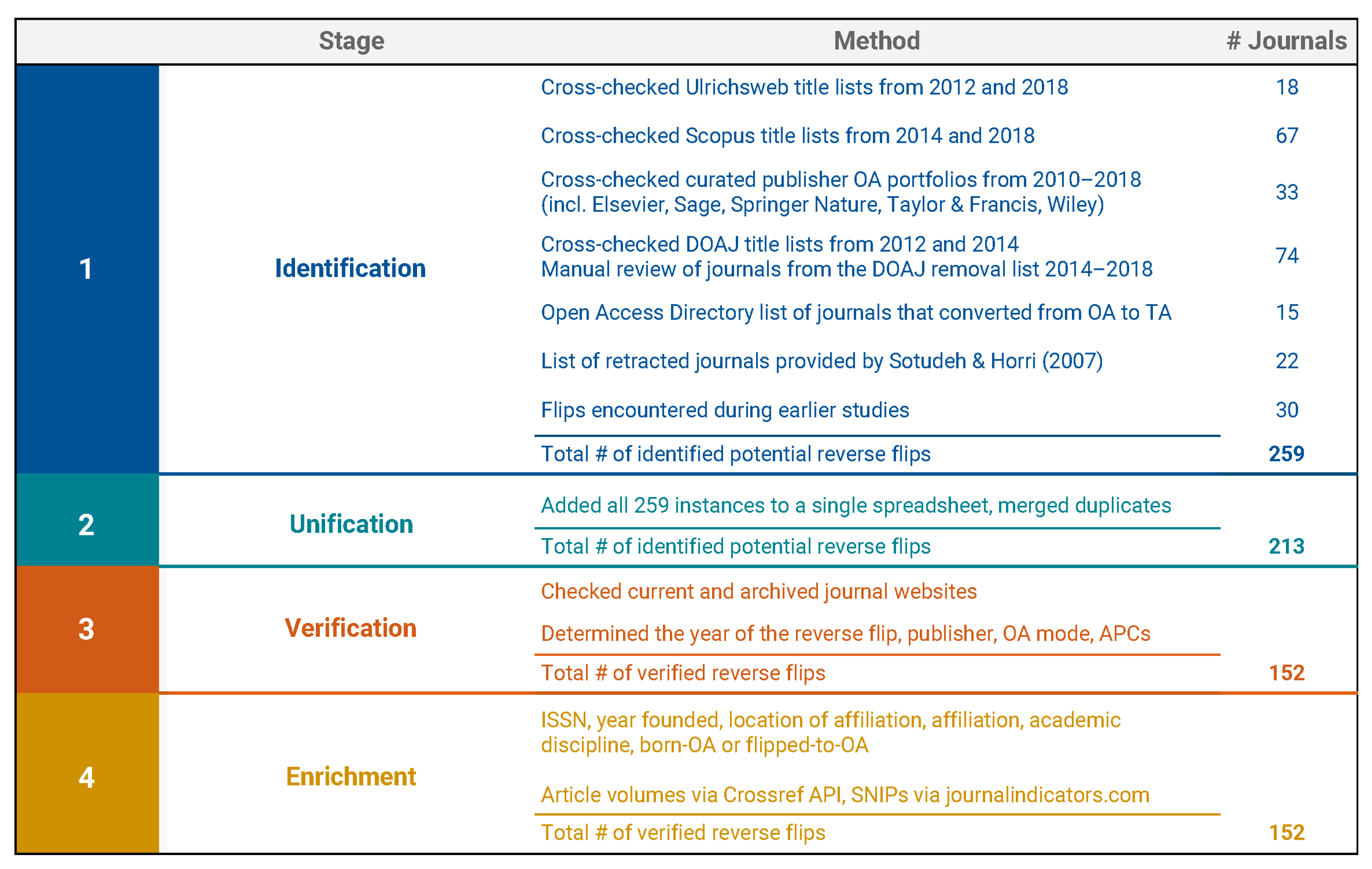

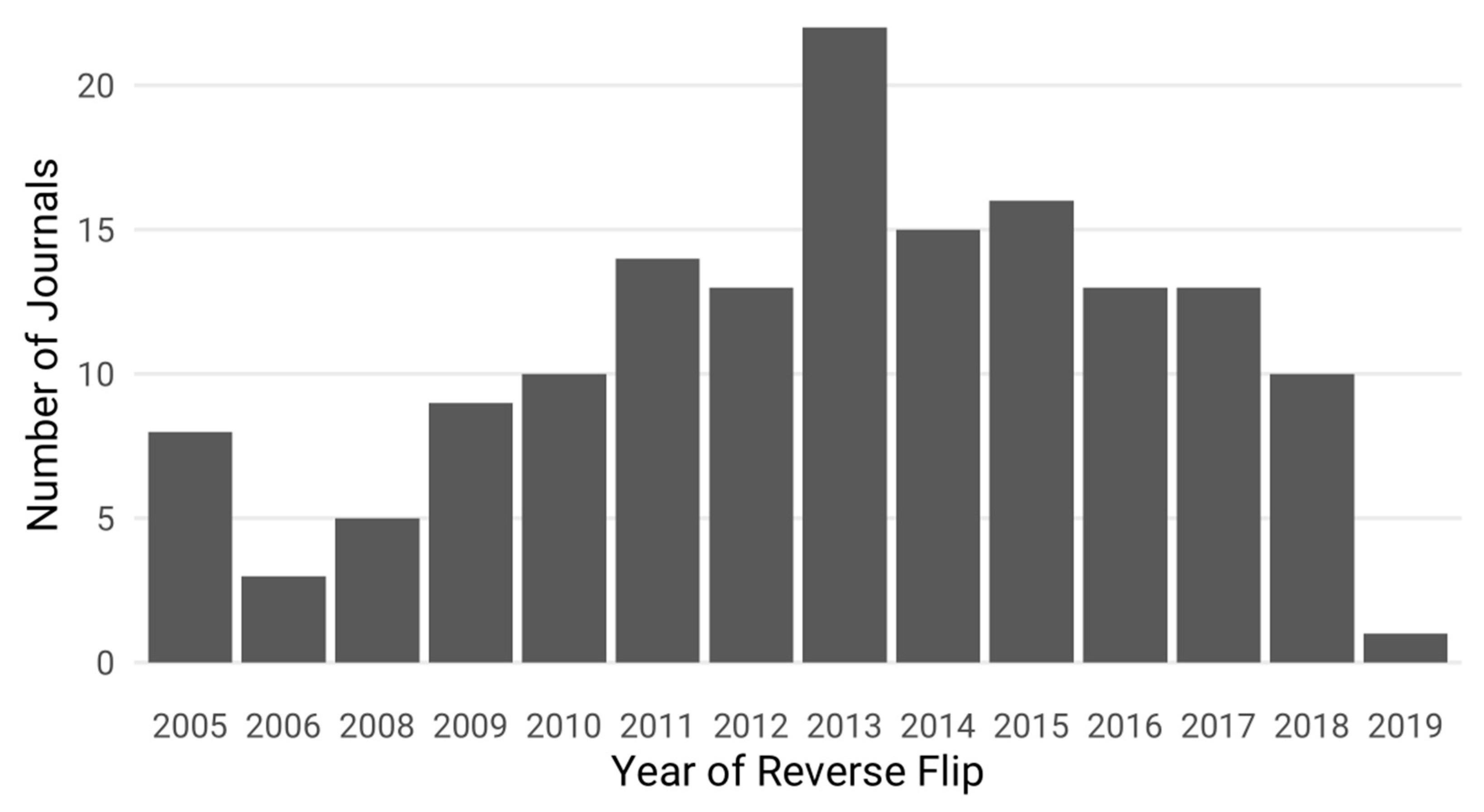
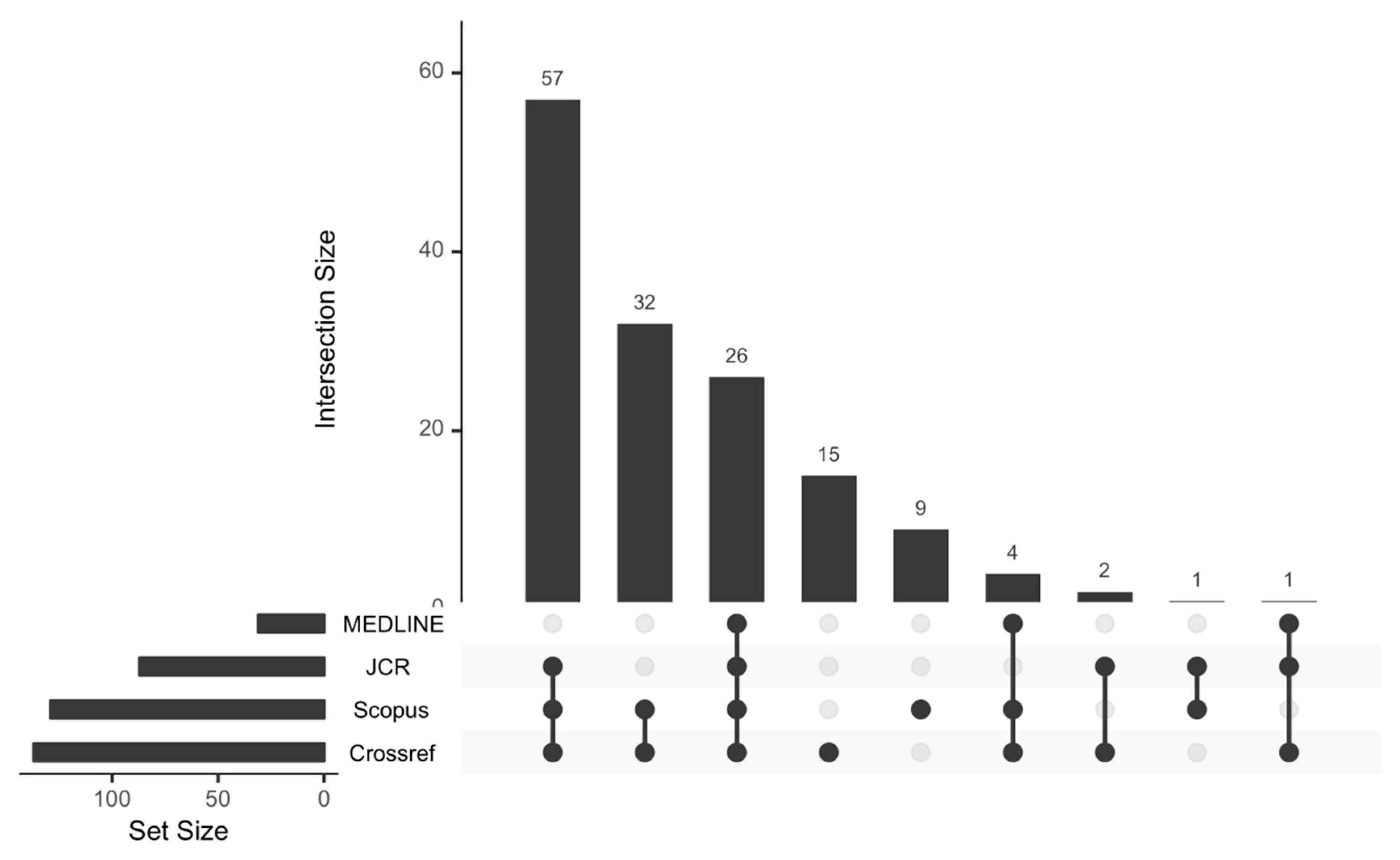
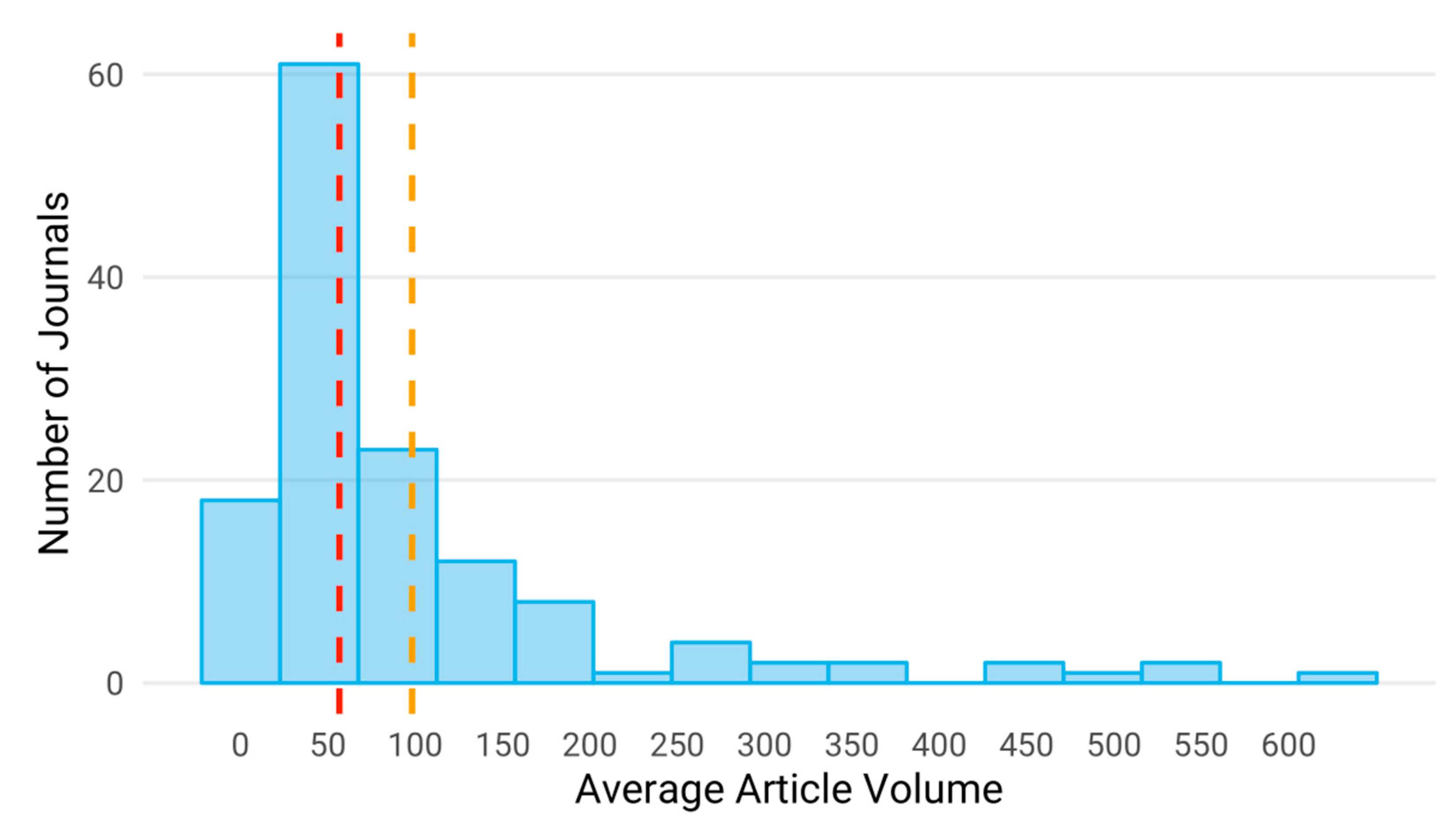

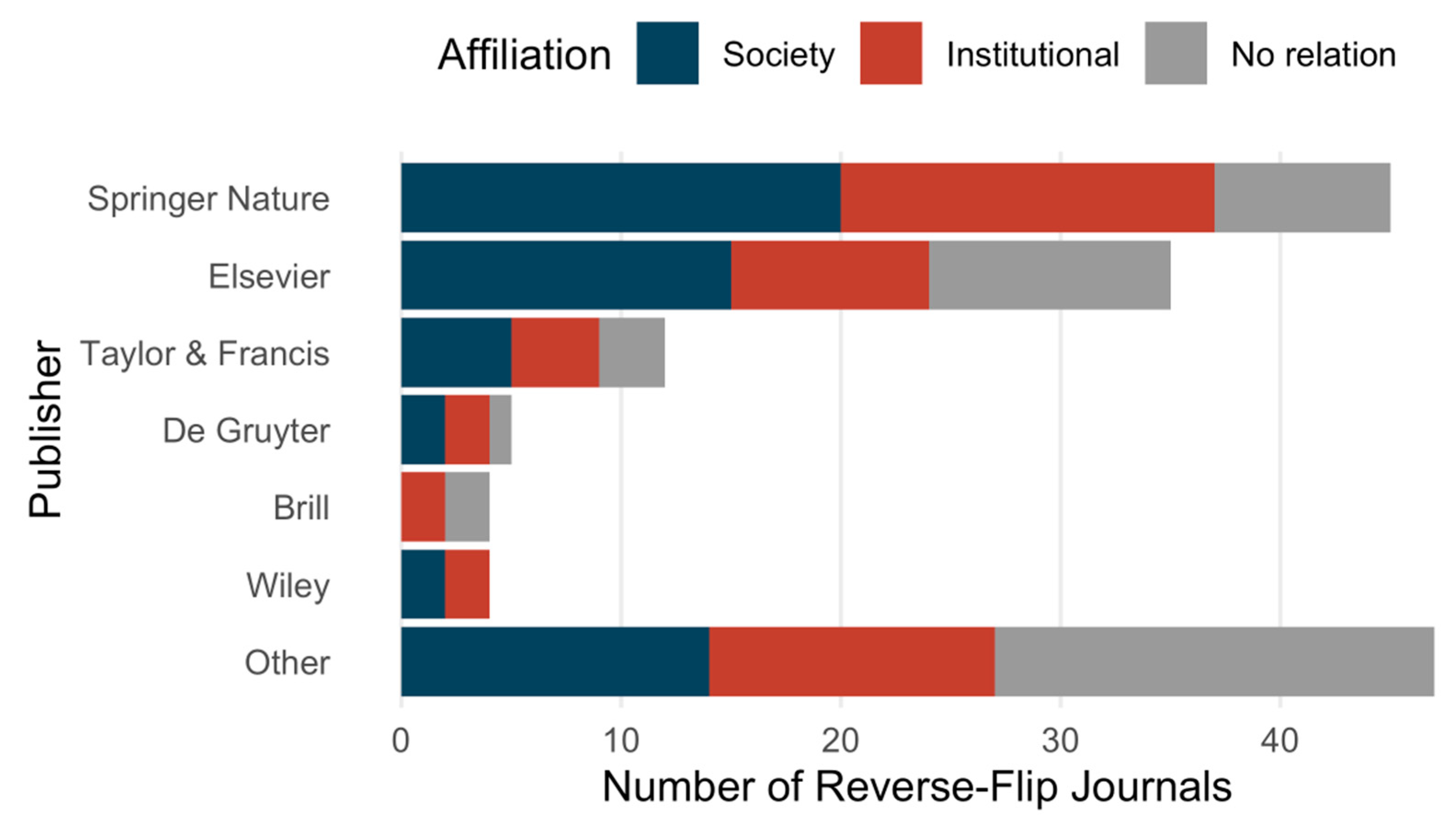
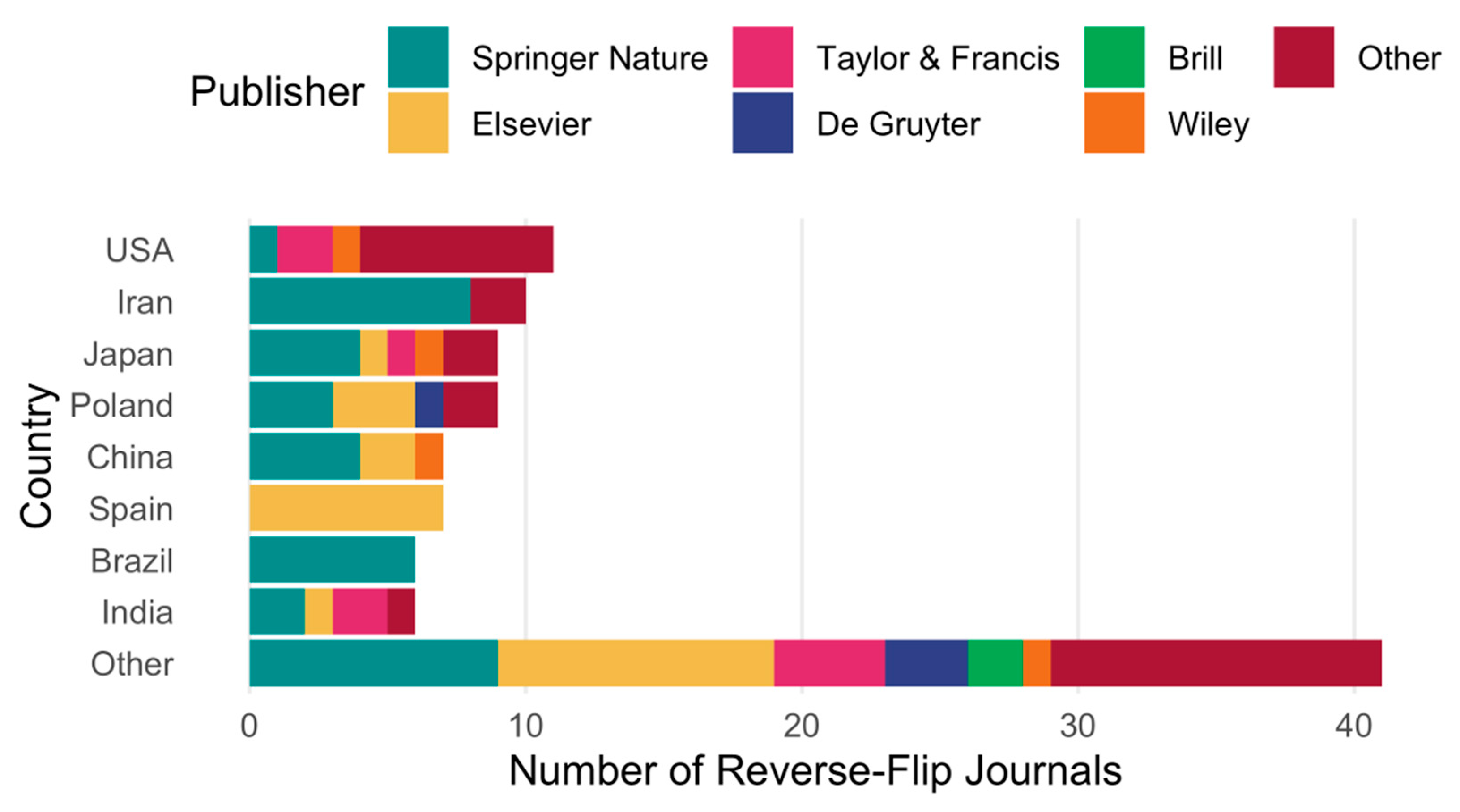
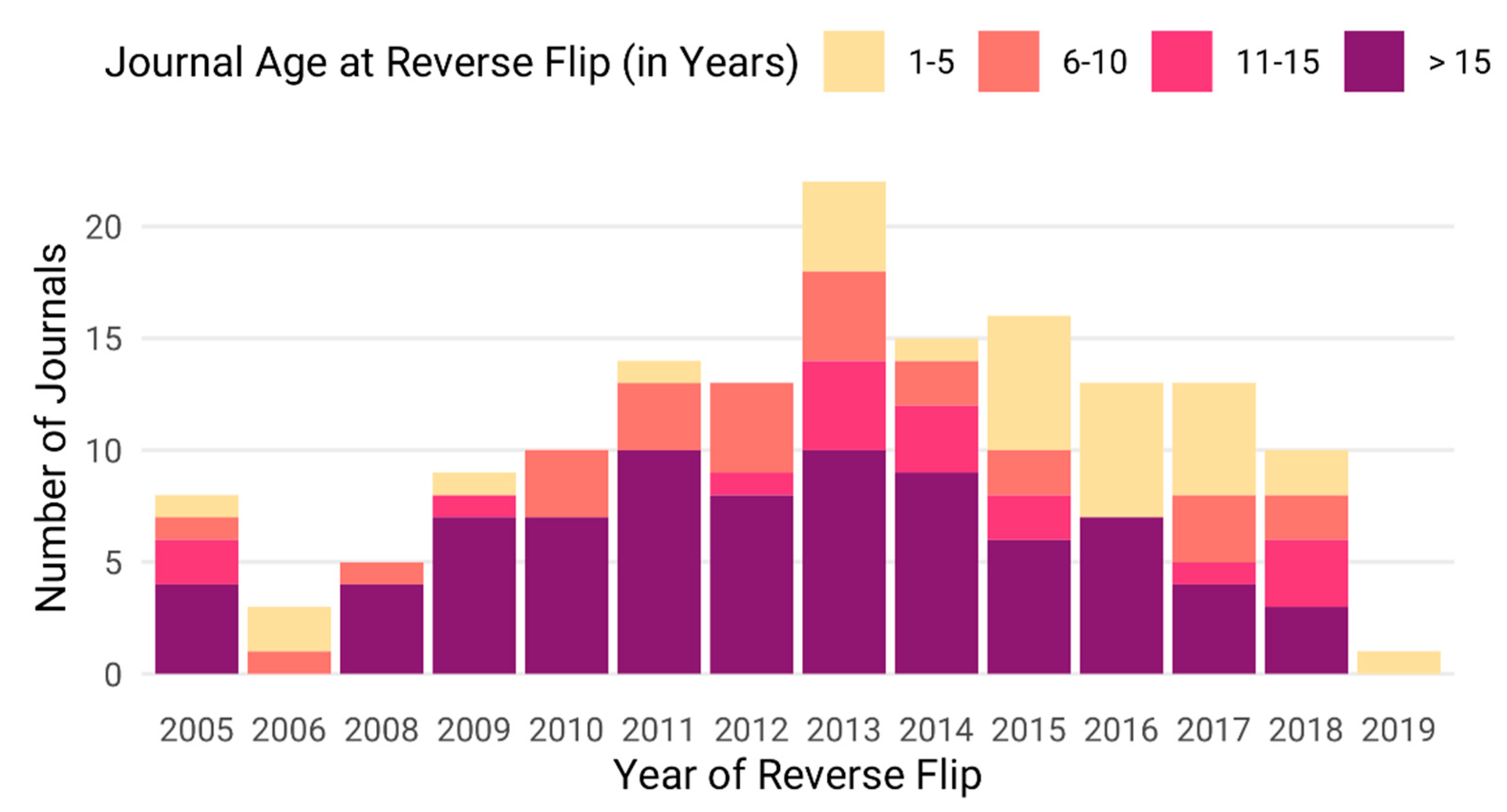
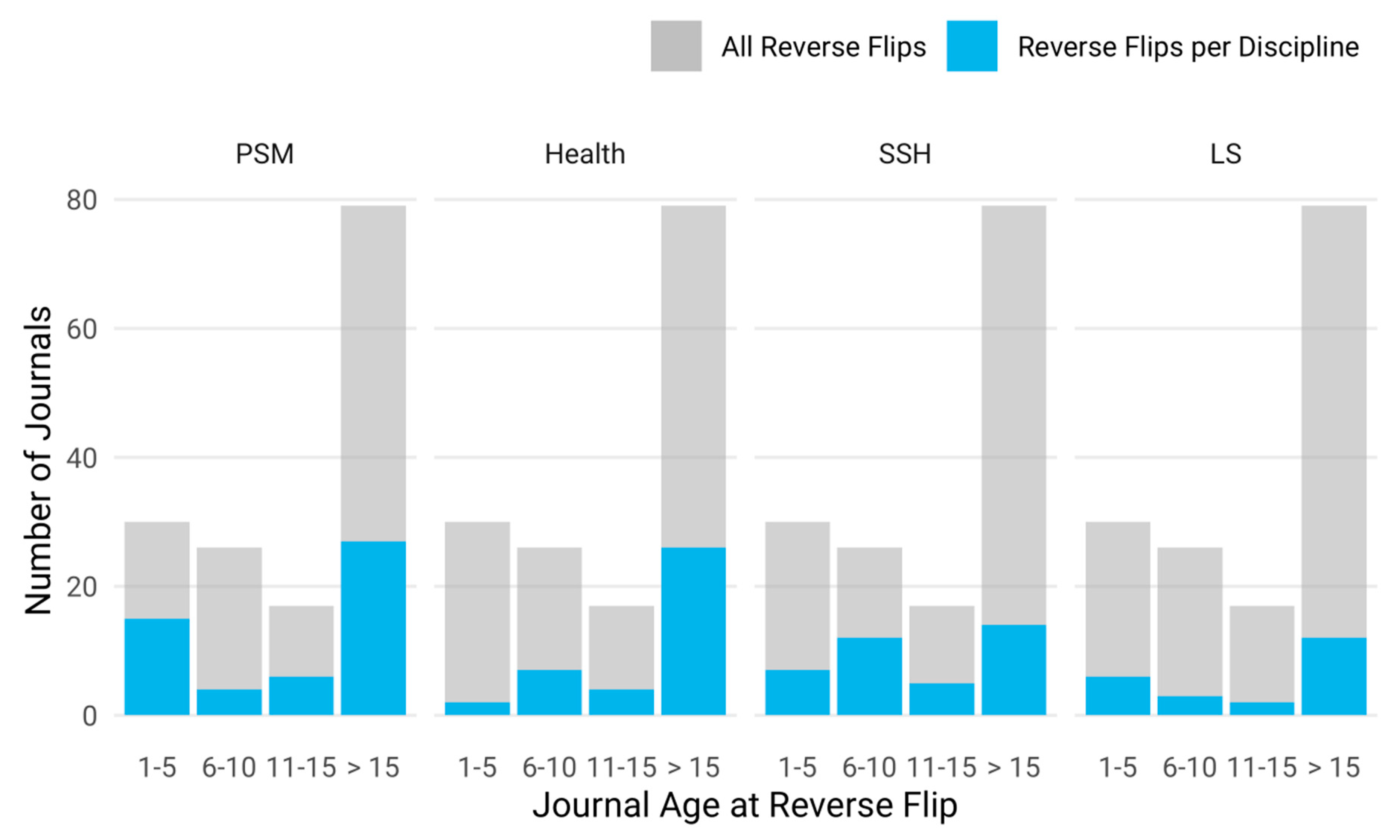
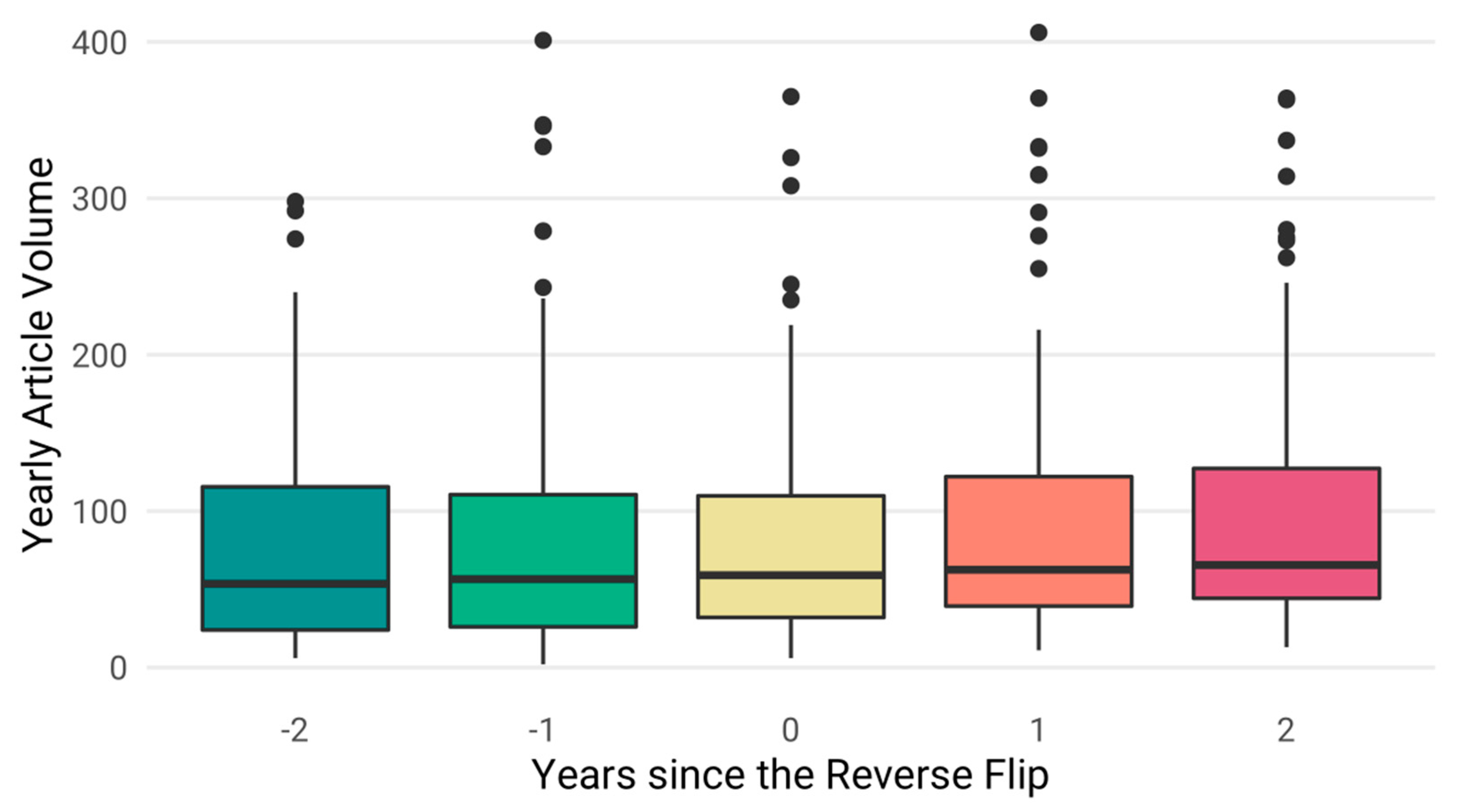
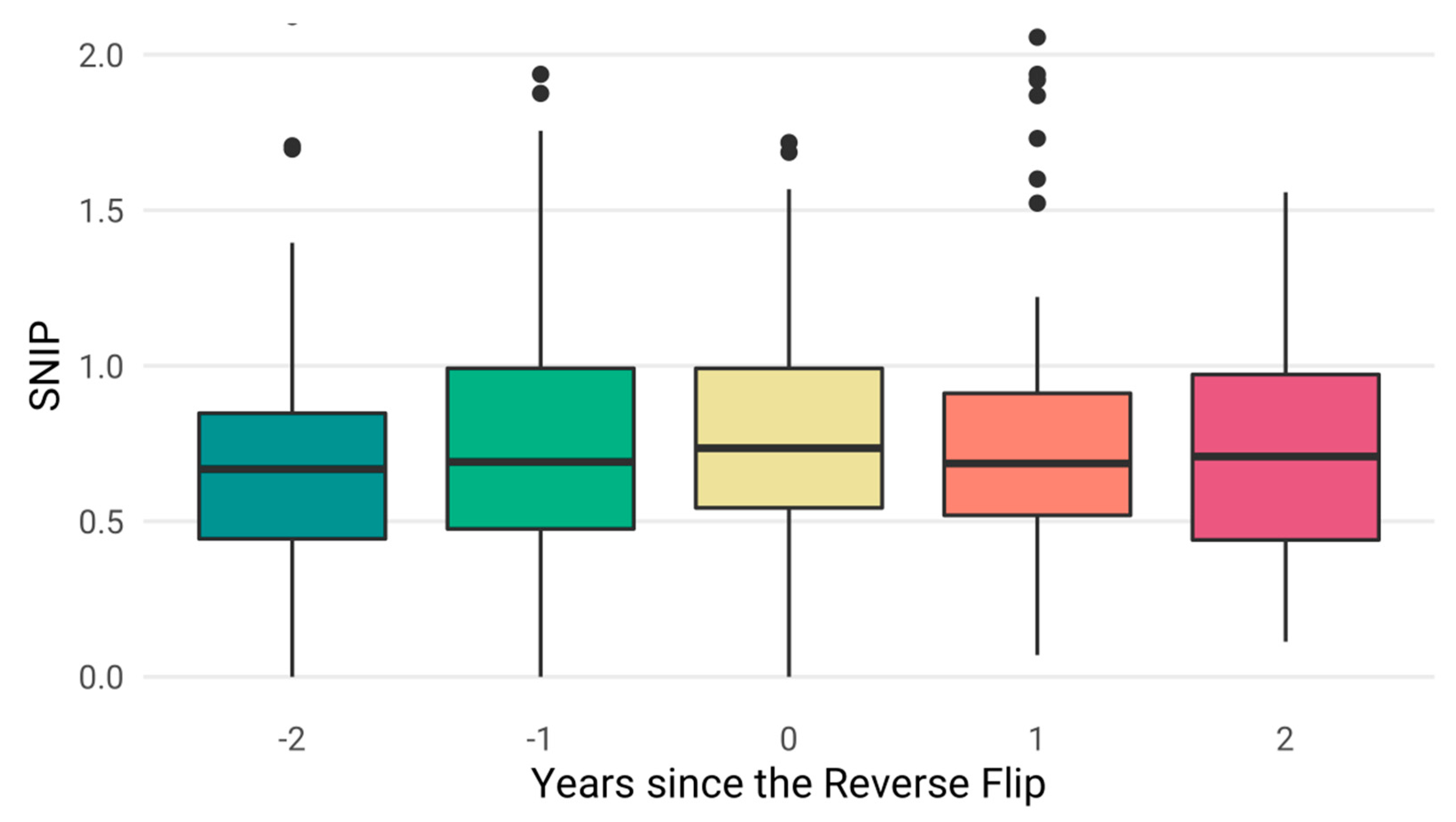
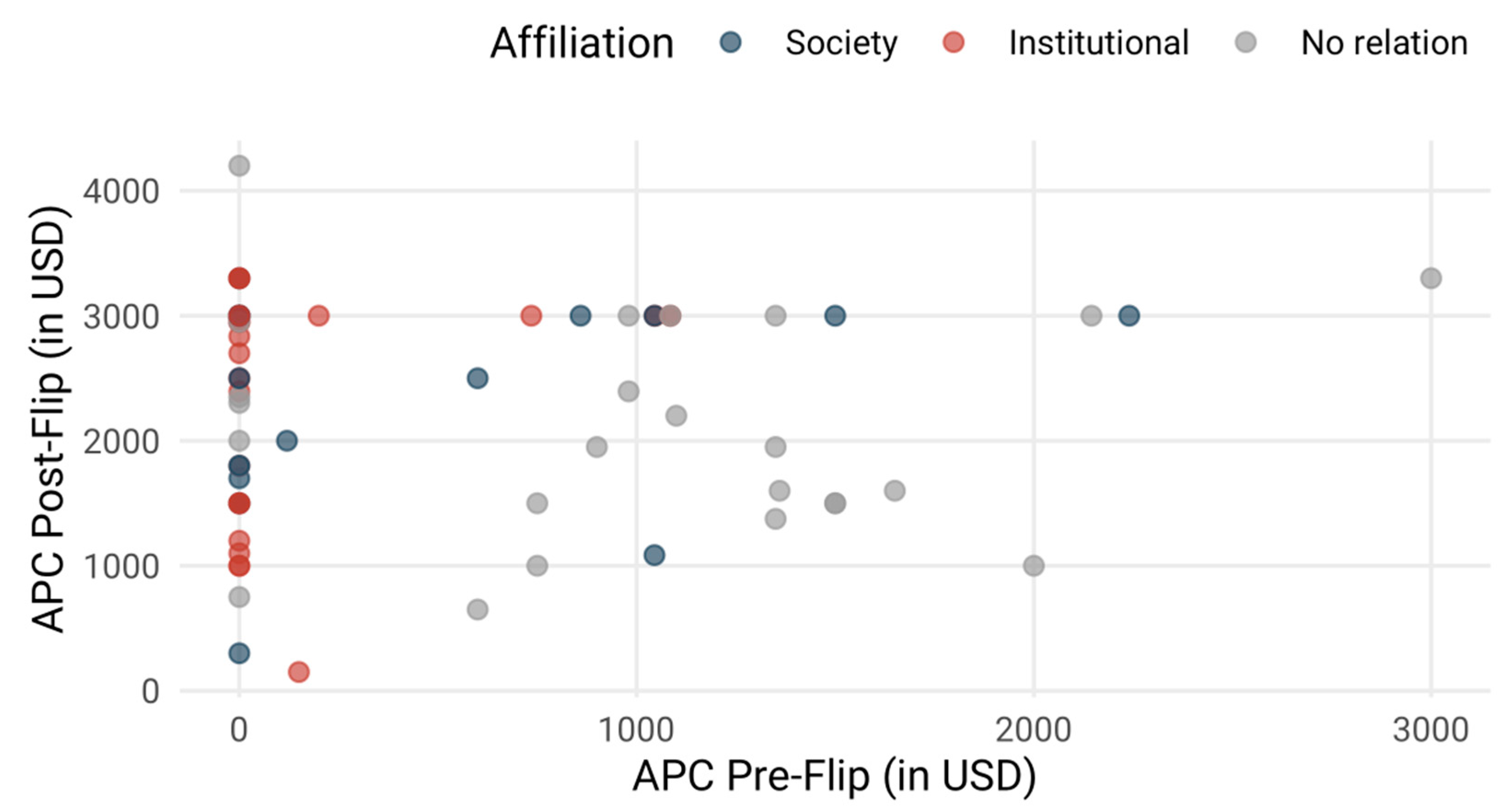
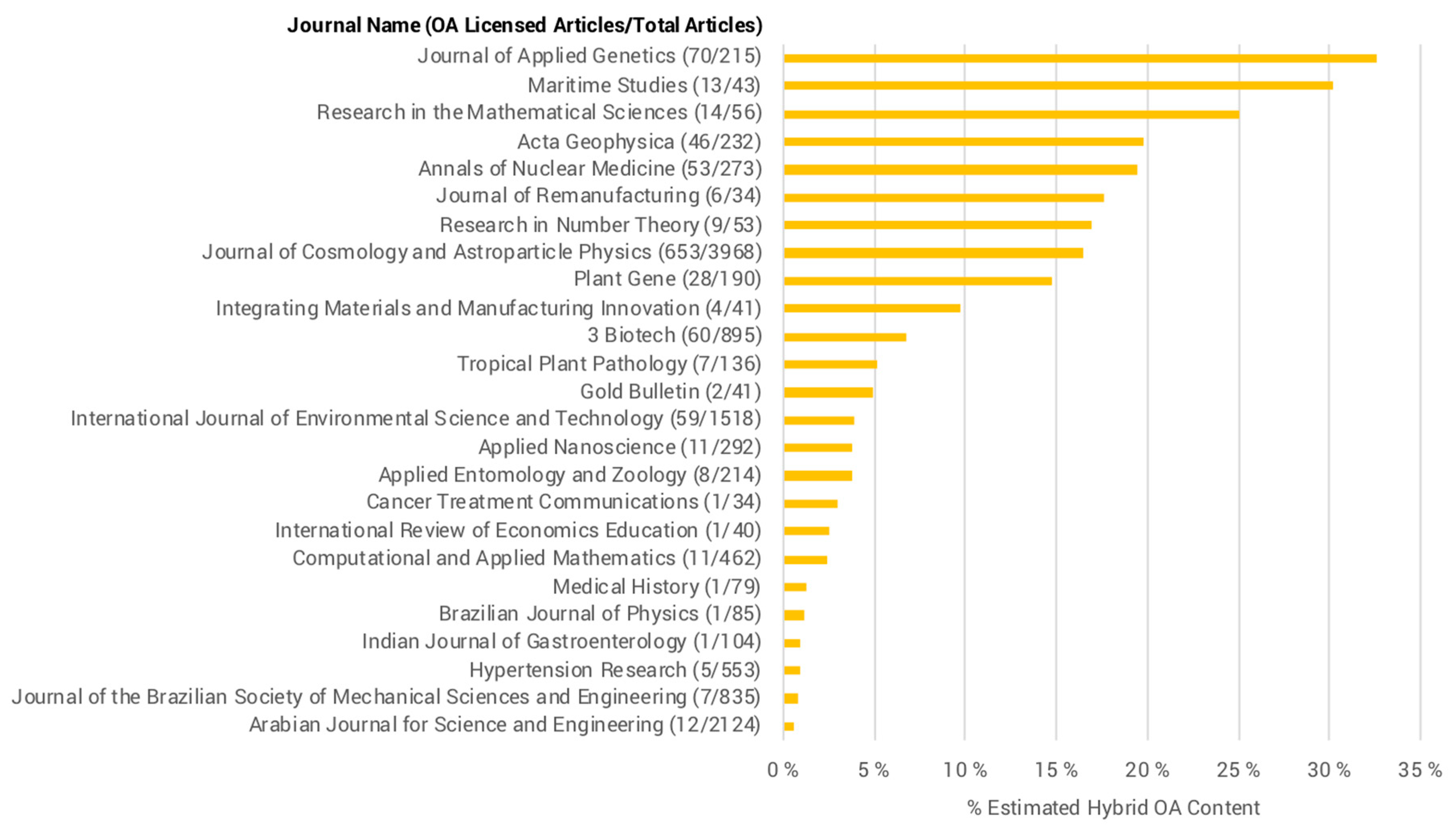
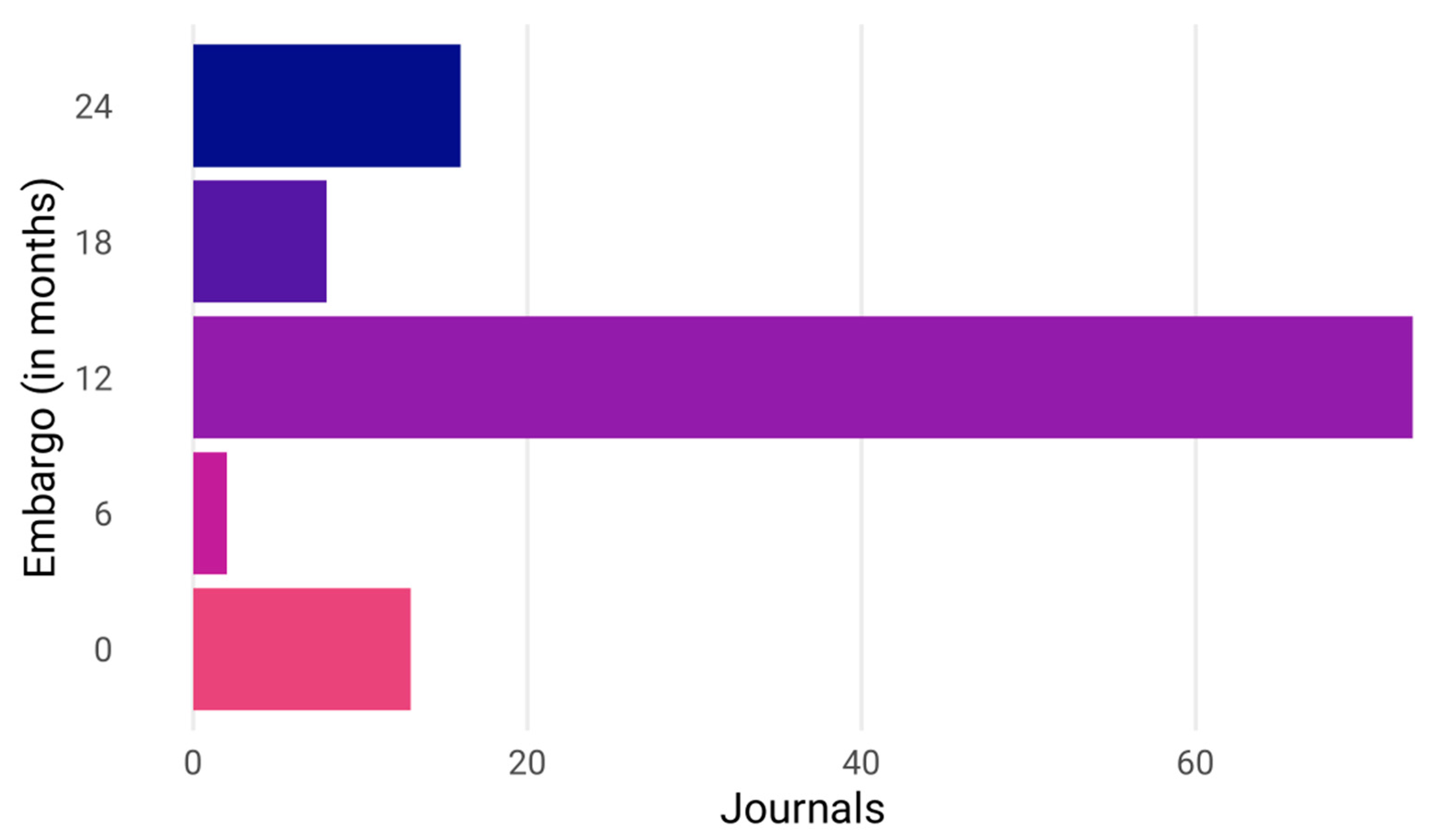
| Discipline | Reverse-Flip Journals | Proportion (in %) |
|---|---|---|
| Physical Sciences and Mathematics | 52 | 34 |
| Health Sciences | 39 | 26 |
| Social Sciences and Humanities | 38 | 25 |
| Life Sciences | 23 | 15 |
| Total | 152 | 100 |
| Publisher | Number of Reverse-Flip Journals Post-Flip | Proportion (in %) | Current Number of Reverse-Flip Journals | Proportion (in %) |
|---|---|---|---|---|
| Springer Nature | 45 | 29.6 | 41 | 27.0 |
| Elsevier | 35 | 23.0 | 34 | 22.4 |
| Taylor & Francis | 12 | 7.9 | 14 | 9.2 |
| De Gruyter | 5 | 3.3 | 7 | 4.6 |
| Brill | 4 | 2.6 | 4 | 2.6 |
| Wiley | 4 | 2.6 | 4 | 2.6 |
| Other | 47 | 30.9 | 48 | 31.6 |
| Total | 152 | 100.0 | 152 | 100.0 |
| Journal Age (in Years) | |
|---|---|
| Mean | 25 |
| Median | 16 |
| Standard Deviation | 22 |
| Minimum | 1 |
| Maximum | 124 |
| Q1 | 7 |
| Q3 | 39 |
| Access Model | Number of Journals | Proportion (in %) |
|---|---|---|
| Hybrid | 76 | 50 |
| Subscription | 76 | 50 |
| Total | 152 | 100 |
| Sponsor | Hybrid OA Articles in Reverse-Flip Journals | All OA Articles | Proportion (in%) |
|---|---|---|---|
| United Kingdom | 22 | 10,289 | 0.21 |
| Sweden | 10 | 3285 | 0.30 |
| Austria | 5 | 1721 | 0.29 |
| Max Planck Agreement (Germany) | 3 | 621 | 0.48 |
| Netherlands | 2 | 6085 | 0.03 |
© 2019 by the authors. Licensee MDPI, Basel, Switzerland. This article is an open access article distributed under the terms and conditions of the Creative Commons Attribution (CC BY) license (http://creativecommons.org/licenses/by/4.0/).
Share and Cite
Matthias, L.; Jahn, N.; Laakso, M. The Two-Way Street of Open Access Journal Publishing: Flip It and Reverse It. Publications 2019, 7, 23. https://doi.org/10.3390/publications7020023
Matthias L, Jahn N, Laakso M. The Two-Way Street of Open Access Journal Publishing: Flip It and Reverse It. Publications. 2019; 7(2):23. https://doi.org/10.3390/publications7020023
Chicago/Turabian StyleMatthias, Lisa, Najko Jahn, and Mikael Laakso. 2019. "The Two-Way Street of Open Access Journal Publishing: Flip It and Reverse It" Publications 7, no. 2: 23. https://doi.org/10.3390/publications7020023
APA StyleMatthias, L., Jahn, N., & Laakso, M. (2019). The Two-Way Street of Open Access Journal Publishing: Flip It and Reverse It. Publications, 7(2), 23. https://doi.org/10.3390/publications7020023





